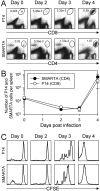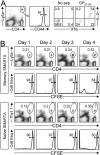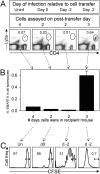Tentative T cells: memory cells are quick to respond, but slow to divide
- PMID: 18404208
- PMCID: PMC2275797
- DOI: 10.1371/journal.ppat.1000041
Tentative T cells: memory cells are quick to respond, but slow to divide
Abstract
T cell memory is a cornerstone of protective immunity, and is the key element in successful vaccination. Upon encountering the relevant pathogen, memory T cells are thought to initiate cell division much more rapidly than their naïve counterparts, and this is thought to confer a significant biological advantage upon an immune host. Here, we use traceable TCR-transgenic T cells to evaluate this proposed characteristic in CD4+ and CD8+ memory T cells. We find that, even in the presence of abundant antigen that was sufficient to induce in vivo IFNgamma production by memory T cells, both memory and naïve T cells show an extended, and indistinguishable, delay in the onset of proliferation. Although memory cells can detect, and respond to, virus infection within a few hours, their proliferation did not begin until approximately 3 days after infection, and occurred simultaneously in all anatomical compartments. Thereafter, cell division was extraordinarily rapid for both naïve and memory cells, with the latter showing a somewhat accelerated accumulation. We propose that, by permitting memory T cells to rapidly exert their effector functions while delaying the onset of their proliferation, evolution has provided a safeguard that balances the risk of infection against the consequences of severe T cell-mediated immunopathology.
Conflict of interest statement
The authors have declared that no competing interests exist.
Figures







Similar articles
-
Bystander sensitization to activation-induced cell death as a mechanism of virus-induced immune suppression.J Virol. 2000 Apr;74(8):3650-8. doi: 10.1128/jvi.74.8.3650-3658.2000. J Virol. 2000. PMID: 10729141 Free PMC article.
-
Acute and chronic B cell depletion disrupts CD4+ and CD8+ T cell homeostasis and expansion during acute viral infection in mice.J Immunol. 2014 Jul 15;193(2):746-56. doi: 10.4049/jimmunol.1302848. Epub 2014 Jun 13. J Immunol. 2014. PMID: 24928986 Free PMC article.
-
Regulation of CD4 T cells and their effects on immunopathological inflammation following viral infection.Immunology. 2017 Oct;152(2):328-343. doi: 10.1111/imm.12771. Epub 2017 Jul 14. Immunology. 2017. PMID: 28582800 Free PMC article.
-
Antigen-specific naive CD8+ T cells produce a single pulse of IFN-γ in vivo within hours of infection, but without antiviral effect.J Immunol. 2014 Aug 15;193(4):1873-85. doi: 10.4049/jimmunol.1400348. Epub 2014 Jul 11. J Immunol. 2014. PMID: 25015828 Free PMC article.
-
CD8 T cell dysfunction during chronic viral infection.Curr Opin Immunol. 2007 Aug;19(4):408-15. doi: 10.1016/j.coi.2007.06.004. Epub 2007 Jul 25. Curr Opin Immunol. 2007. PMID: 17656078 Review.
Cited by
-
Vaccine Platform Comparison: Protective Efficacy against Lethal Marburg Virus Challenge in the Hamster Model.Int J Mol Sci. 2024 Aug 5;25(15):8516. doi: 10.3390/ijms25158516. Int J Mol Sci. 2024. PMID: 39126087 Free PMC article.
-
Robust humoral and cellular recall responses to AZD1222 attenuate breakthrough SARS-CoV-2 infection compared to unvaccinated.Front Immunol. 2023 Jan 13;13:1062067. doi: 10.3389/fimmu.2022.1062067. eCollection 2022. Front Immunol. 2023. PMID: 36713413 Free PMC article. Clinical Trial.
-
Optimisation of the cultured ELISpot/Fluorospot technique for the selective investigation of SARS-CoV-2 reactive central memory T cells.Front Immunol. 2025 Apr 15;16:1547220. doi: 10.3389/fimmu.2025.1547220. eCollection 2025. Front Immunol. 2025. PMID: 40303392 Free PMC article.
-
Regulation of innate CD8+ T-cell activation mediated by cytokines.Proc Natl Acad Sci U S A. 2012 Jun 19;109(25):9971-6. doi: 10.1073/pnas.1203543109. Epub 2012 Jun 4. Proc Natl Acad Sci U S A. 2012. PMID: 22665806 Free PMC article.
-
Dynamic functional modulation of CD4+ T cell recall responses is dependent on the inflammatory environment of the secondary stimulus.PLoS Pathog. 2014 May 22;10(5):e1004137. doi: 10.1371/journal.ppat.1004137. eCollection 2014 May. PLoS Pathog. 2014. PMID: 24854337 Free PMC article.
References
-
- Veiga-Fernandes H, Walter U, Bourgeois C, McLean A, Rocha B. Response of naive and memory CD8+ T cells to antigen stimulation in vivo. Nat Immunol. 2000;1:47–53. - PubMed
-
- Rogers PR, Dubey C, Swain SL. Qualitative changes accompany memory T cell generation: faster, more effective responses at lower doses of antigen. J Immunol. 2000;164:2338–2346. - PubMed
-
- Slifka MK, Whitton JL. Functional avidity maturation of CD8+ T cells without selection of higher affinity TCR. Nat Immunol. 2001;2:711–717. - PubMed
-
- Lefrancois L. Development, trafficking, and function of memory T-cell subsets. Immunol Rev. 2006;211:93–103. - PubMed
Publication types
MeSH terms
Substances
Grants and funding
LinkOut - more resources
Full Text Sources
Other Literature Sources
Research Materials

